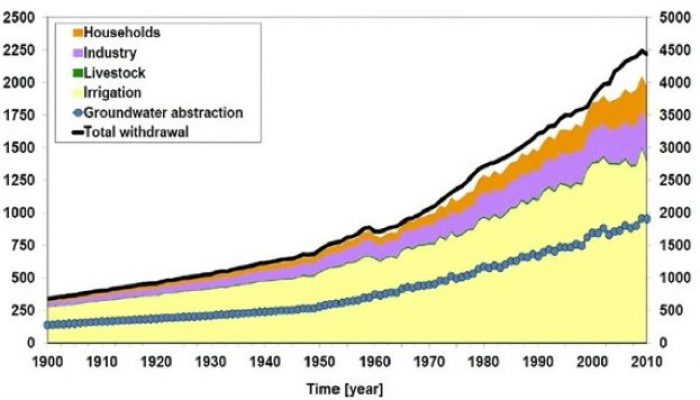
Post by Inge de Graaf, University of Freiburg, Environmental Hydrological Systems group
________________________________________________________________________________________________________________
Last week I had to teach my first class in global hydrology. When I showed the global trend on increasing demands and withdrawals (see Figure) I needed to explain the different terms as sometimes the term “water use” gets, well, misused.
The term “water use” often fails to adequately describe what happens to the water. So I told the students; if you see or hear to term ‘water use’ always ask yourself what’s actually being said. The term is often used for water withdrawals or water consumption, and it’s important to understand the difference.
Water withdrawal describes the total amount of water withdrawn from a surface water or groundwater source. Measurements of this withdrawn water help evaluate demands from domestic, industrial and agricultural users.
Water consumption is the portion of the withdrawn water permanently lost from its source. This water is no longer available because it evaporated, got transpired or used by plants, or was consumed by people or livestock. Irrigation is by far the largest water consumer. Globally irrigated agriculture accounts for 70% of the total water used and almost 50% is lost either by evaporation or transpiration.
Understanding both water withdrawal and consumption is critical to properly evaluate water stress. Measurements of water withdrawal indicate the level of competition and dependence on water resources. Water consumption estimates help to quantify the impact of water withdrawals on downstream availabilities and are essential to evaluate water shortage and scarcity. For example, most water used by households is not consumed and flows back as return flow and can be reused further downstream. However, water is rarely returned to watershed after being used by households or industry without changing the water quality, increasing water stress levels.
Already more than 1.4 billion people live in areas where the withdrawal of water exceeds recharge rates. In the coming decades global population is expected to increase from 7.3 billion now, to 9.7 billion by 2050 (UN estimate). This growth, along with rising incomes in developing countries, is driving up global food demands. With food production estimated to increase by at least 60% (FAO estimate), predicting water withdrawal and consumption is critically important for identifying areas that are at risk of water scarcity and where water use is unsustainable and competition amongst users exist.

Global trend I showed in my class, published in Wada et al (2016).
Ref:
Wada, Y., I. E. M. de Graaf, and L. P. H. van Beek (2016), High-resolution modeling of human and climate impacts on global water resources, J. Adv. Model. Earth Syst., 8, 735–763, doi:10.1002/2015MS000618.




